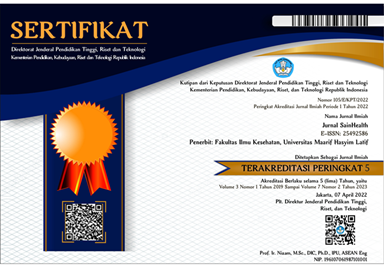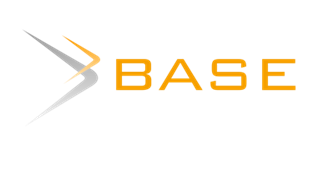DETEKSI Escherichia coli PATOGEN PADA PANGAN MENGGUNAKAN METODE KONVENSIONAL DAN METODE MULTIPLEX PCR
DOI:
https://doi.org/10.51804/jsh.v1i2.107.75-82Keywords:
Escherichia coli, foodstuffs, conventional method, multiplex PCR methodAbstract
Foodstuffs are a source of nutrition for humans and as well as a source of food for microorganisms. Microbes can contaminate food through water, dust, air, soil, processing tools (during production or preparation processes, as well as secretions from human and animal guts). Food can be toxic because it has been contaminated by pathogenic bacteria which can then grow and multiply during storage, so the bacteria are able to produce toxins that are harmful to humans. The aimed of this study was to detect the presence of Escherichia coli pathogen in food. This type of research is experimental laboratory using conventional method and multiplex PCR method. 8 positive samples of Escherichia coli ATCC 25922 by conventional method, consisting of 5 samples of tofu; 2 samples of ice syrup and 1 sample iced tea. All positive samples in EMB agar continued Escherichia coli pathogen detection using PCR multiplex method. From the PCR multiplex test, no samples were detected Escherichia coli pathogenReferences
Biswas, S., M.A.K. Parves, M. Shafiquzzaman, S. Nahar and M.N. Rahman. 2010. Isolation and Characterization of Escherichia coli in Ready-to-eats Foods Vended in Islamic University Kushtia. J. Biol-Sci. 18 : 99-103.
BPOM. 2008. Pengujian Mikrobiologi Pangan. InfoPOM. 9(2) : 1-9. BPOM. 2015. Listeria monocytogenes Sebagai Agen Penyebab Keracunan Pangan. InfoPOM. 16 (1) : 3-5.
Djoepri, M.R. 2006. Isolasi dan Identifikasi Mikroba Escherichia coli pada Makanan Sosis dan Nuget. Temu Teknis Nasional Tenaga Fungsional Pertanian. 265-268.
Huang, D.B., Mohanty, Dupont, H.L., Okhuysen, P.C. and Chiang T. 2006. A Review of An Emeging Enteric Pathogen Enteroaggregative Escherichia coli. J. Med-Microbiol. 55 : 1303-1311.
International Standard Organization. 2006. Milk and Milk Product : Detection Enterobacter sak azak ii. First Esition. 22964. IDF/RM 210.
Kumar, S.H., Iddya, K., Karunasajar, I. 2002. Molecular. Methods for Rapid and Specific detection of Pathogens in Seafood. Aquacult Asia 3. 34-37.
Mailia, R., B. Yudhistira, Y. Pranoto, dan S. Rochdyanto. 2015. Ketahanan Panas Cemaran Mikroba Escherichia coli, Staphylococcus aureus, Bacillus cereus dan Bakteri Pembentuk Spora yang Diisolasi dari Proses Pembuatan Tahu di Sudagaran Yogyakarta. Agritech. 35 (3) : 300-308.
Peraturan BPOM Hk.00.061.1.52.4011. 2009. Penetapan Batas Maksimum Cemaran Mikroba dan Kimia Dalam Makanan. Perreten, V. 2005. Resistance in the Food Chain in Bacteria From Animals : Relevance to Human Infections, In White D.G., Aleksum M.N., McDemont PF (eds). Frontiers in Antimicrobial Resistance. ASM Press. Washington DC. 446-464 pp.
Rajkovic, A., Kljajic, M., Smigic, N., Devlieghere, F., and Uttendale, M. 2013. Toxin Producing Bacillus cereus Persist in Ready-to-reheat Spagheti Bolognese Mainly in Vegetative State. International Journal of Food Microbiology. 167 : 236-243.
Ritonga, R., I. Marsaulina dan I. Chahaya. 2013. Analisis Escherichia coli dan Higiene Sanitasi pada Minuman Es Teh yang Dijual di Pajak Karona Jamin Ginting, Kec. Medan Baru. FKM. USU.
Siagian, A. 2002. Mikroba Patogen pada Makanan dan Sumber Pencemarannya. USU Digital Library. FKM. Univ. Sumatera Utara. Then Human Body. Chapman and Hall. London
Downloads
Published
Issue
Section
License
Jurnal SainHealth is licensed under Creative Commons Attribution 4.0 International License.
Under the following terms:
Attribution — You must give appropriate credit, provide a link to the license, and indicate if changes were made. You may do so in any reasonable manner, but not in any way that suggests the licensor endorses you or your use.
No additional restrictions — You may not apply legal terms or technological measures that legally restrict others from doing anything the license permits.
















